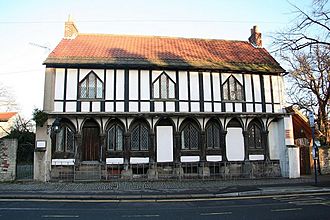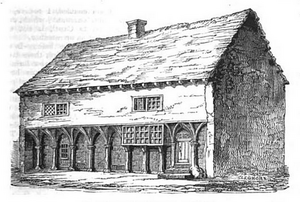St Leonard's Hospital, Tickhill facts for kids
Quick facts for kids St Leonard's Hospital |
|
|---|---|
 |
|
| General information | |
| Address | Northgate, Tickhill |
| Completed | 1470 |
| Renovated | 1851 |
St Leonard's Hospital is a very old building in Tickhill, South Yorkshire, England. It's made of wood and is considered a special historic building. It was first built in the 1400s as a place for people connected to a monastery.
Contents
History of St Leonard's Hospital
The First Hospital
The very first hospital in Tickhill named after Saint Leonard was on Spital Hill. This area was a bit marshy and outside the main town. It was a good spot for people with Leprosy, a serious skin disease.
This first hospital was already there by 1225. At that time, Walter de Gray, who was the Archbishop of York, said the people working there needed help. He asked for donations to improve the hospital. People with leprosy were mentioned there in 1236. Later, in 1290, a person named John Clarel tried to make things better at the hospital.
Moving to the Town Centre
In 1470, the hospital moved to a new spot. It went to the north side of Tickhill Market Place. A message above the door suggests that John Leftwul helped rebuild it. We don't know why it moved.
However, experts believe that moving to the town centre meant its purpose changed. Town centres were not suitable places for people with leprosy. The building slowly became less important. By the 1840s, it was being used as small apartments. But its front still looked mostly the same.
Restorations and New Uses
The hospital building was greatly fixed up in 1851. The top floor was completely rebuilt in a Gothic style. This style looks like old medieval buildings.
In 1898, the local church bought the building. They turned it into a meeting room for the church community. The building was fixed up again in 2007 to keep it in good condition.
What Does It Look Like Today?
Today, St Leonard's Hospital has ten sections, separated by wooden posts. These posts hold up the top floor, which sticks out a bit. The top floor has three special windows. They have straight sides but pointed tops.
The building was officially made a listed building in 1961. This means it's protected because of its history and special design. It is currently listed at grade II*, which is a very high level of protection.


